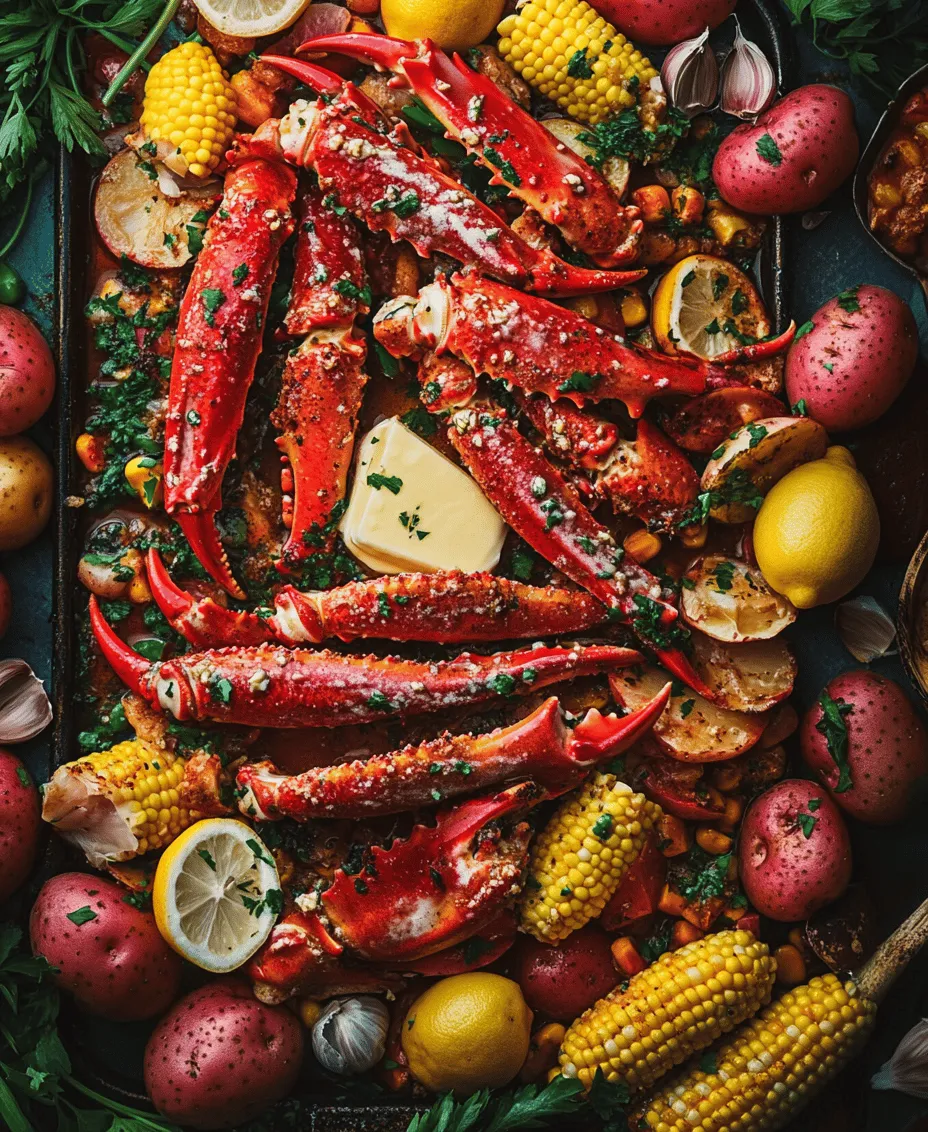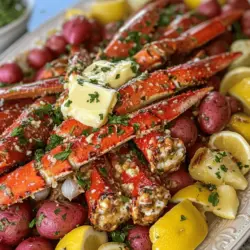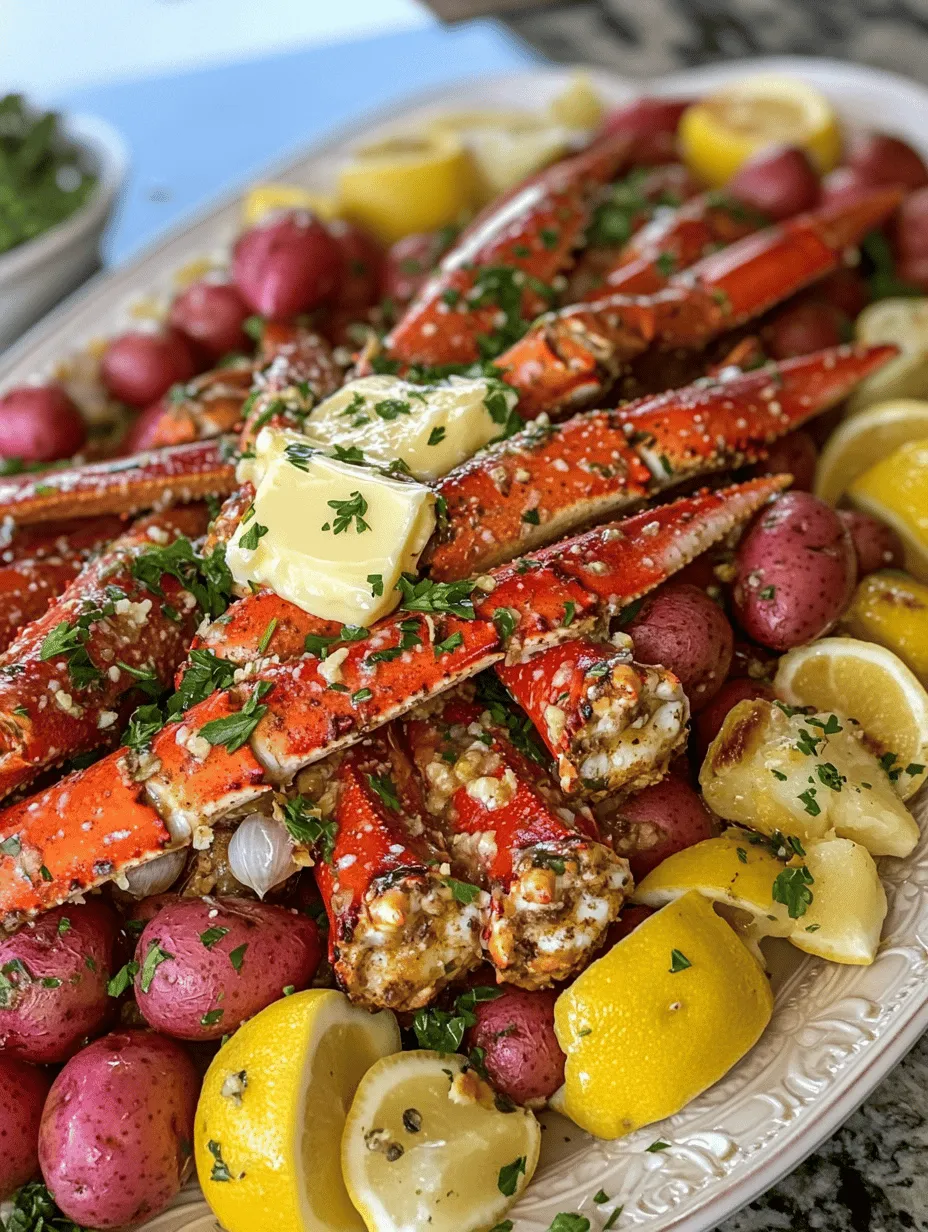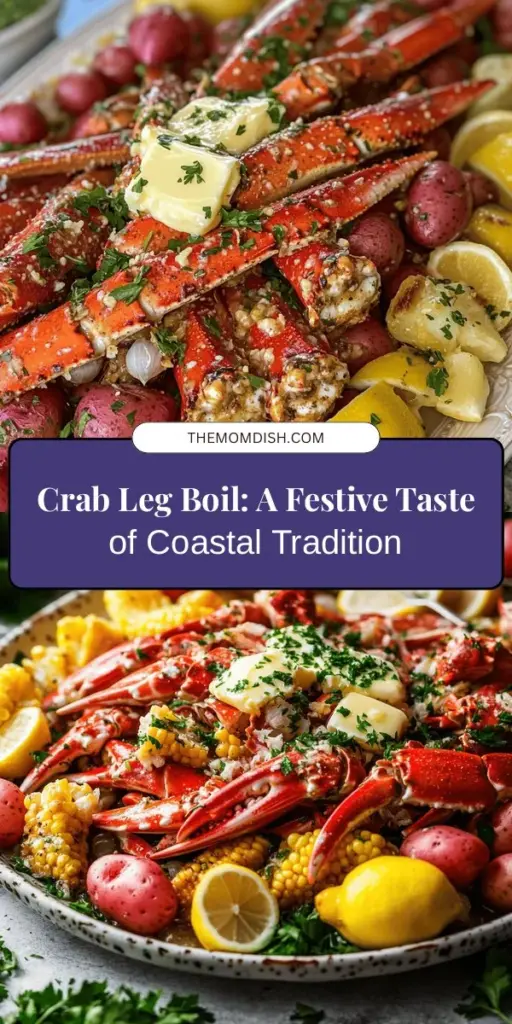Introduction
A crab leg boil is not just a meal; it’s a culinary tradition steeped in coastal culture and communal enjoyment. This vibrant dish, brimming with the flavors of the sea, brings people together for lively gatherings filled with laughter and delicious food. The concept of boiling crab legs alongside fresh vegetables creates an inviting atmosphere, making it the perfect centerpiece for family reunions, summer barbecues, or holiday celebrations. The simplicity of the preparation allows the natural sweetness of the crab to shine, while the spices and accompaniments elevate the dish to something truly memorable.
As we delve into the “Crab Leg Boil Delight,” you’ll discover how to create this exceptional dish that highlights the succulent taste of crab legs paired with fresh produce and spices. Whether you’re a seasoned seafood lover or trying this for the first time, this recipe invites you to savor the flavors of the ocean right in your home.
Understanding Crab Legs
Before diving into the preparation, it’s essential to understand the types of crab legs available and their unique characteristics.
Types of Crab Legs: Snow Crab vs. King Crab
When it comes to crab legs, two popular varieties reign supreme: snow crab and king crab. Each type offers distinct flavors and textures, making them suitable for different culinary experiences.
Snow Crab
Snow crab legs are known for their delicate, sweet flavor and tender texture. They are typically smaller and more slender than king crab legs, making them easier to handle and eat. Snow crabs are widely available and often more affordable, especially during peak fishing seasons. Their meat is flaky and easy to extract from the shell, making them an excellent choice for crab boils.
King Crab
On the other hand, king crab legs are a feast for the senses, boasting a rich, buttery flavor and a meaty texture that is hard to resist. These legs are significantly larger than snow crab legs and contain more meat, making them a luxurious option for special occasions. King crabs are often more expensive and may be harder to find, but their flavor and presentation make them worth the investment.
Nutritional Benefits of Crab
In addition to their delectable taste, crab legs are packed with nutritional benefits. They are an excellent source of high-quality protein, making them a great option for those looking to maintain a healthy diet. A typical serving of crab legs contains around 20 grams of protein, which is essential for muscle growth and repair.
Crab is also rich in vitamins and minerals, including:
– Vitamin B12: Essential for red blood cell formation and neurological function.
– Selenium: An important antioxidant that helps protect cells from damage.
– Zinc: Crucial for immune function and wound healing.
Incorporating crab legs into your diet not only satisfies your seafood cravings but also contributes to your overall nutritional intake.
Ingredients Breakdown
To create the perfect crab leg boil, selecting high-quality ingredients is crucial. Here’s a breakdown of what you’ll need for an unforgettable Crab Leg Boil Delight.
Essential Ingredients for the Perfect Crab Leg Boil
1. Crab Legs: Choosing the right type is fundamental. Whether you opt for snow crab or king crab, ensure they are fresh and sourced from reputable suppliers. Frozen crab legs can also be used; just make sure to thaw them properly before cooking.
2. Seasonings: The cornerstone of any great boil is the seasoning. Old Bay seasoning is a traditional favorite, offering a blend of spices that enhance the crab’s natural sweetness. Other spices like cayenne pepper can be added if you enjoy a bit of heat.
3. Fresh Produce: Accompaniments play a vital role in balancing the dish. Lemons, garlic, and onions add aromatic flavors, while potatoes and corn contribute substance. The vibrant colors and textures of these ingredients elevate the visual appeal of the meal.
4. Butter and Optional Ingredients: Melted butter is a classic accompaniment for crab legs, enhancing their richness. For an extra kick, consider adding cayenne pepper or hot sauce to the butter for dipping.
Importance of Ingredient Quality
The quality of your ingredients can significantly impact the flavor and presentation of your dish. Fresh crab legs are essential for achieving that sweet, briny taste characteristic of seafood. When sourcing crab legs, look for those that are kept on ice and have a fresh, ocean-like scent.
Similarly, fresh vegetables should be firm and vibrant in color. When you use high-quality produce, you enhance not just the flavor but also the nutritional value of your dish.
Step-by-Step Preparation Guide
Now that you have a clear understanding of the ingredients, let’s move on to the preparation process. A well-executed crab leg boil involves a few key steps that ensure the flavors meld beautifully.
Preparing the Boiling Pot
Start by selecting a large pot that can accommodate all your ingredients comfortably. A stockpot with a capacity of at least 5 to 6 quarts is ideal for a crab leg boil. Fill the pot with water, leaving enough space for the ingredients to submerge once added.
Next, bring the water to a rolling boil over high heat. To infuse flavor into the water, add generous amounts of Old Bay seasoning along with a few slices of lemon and whole garlic cloves. This step is crucial, as it sets the foundation for a flavorful boil.
Cooking Process Explained
Once the water reaches a boil, it’s time to add your ingredients in stages, ensuring everything cooks to perfection.
1. Potatoes: Start with the potatoes, as they take the longest to cook. Depending on their size, you may need to quarter them to ensure even cooking. Add the potatoes to the boiling water and cook for about 10-15 minutes, or until they are fork-tender.
2. Corn: After the potatoes have had a head start, add the corn to the pot. Fresh corn on the cob adds sweetness and texture; if using frozen corn, it will require less cooking time. Allow the corn to boil for about 5-7 minutes.
3. Crab Legs: Finally, it’s time to add the star of the show—crab legs. If using frozen crab legs, they should be thawed beforehand. Gently lower them into the pot and let them cook for about 5-7 minutes. The key is to heat the crab legs through without overcooking them, which can result in a rubbery texture.
Timing for Each Ingredient
The timing of each ingredient is vital for achieving a perfectly balanced crab leg boil. Remember to keep an eye on the pot and adjust the cooking times as necessary. Once the crab legs are heated through, you can drain the pot and prepare to serve.
In the next part of this article, we will explore some tips for achieving the best results with your crab leg boil, along with answers to common questions. Stay tuned for a delicious journey that will elevate your seafood dining experience!

Tips for Checking Doneness and Ensuring Even Cooking
When preparing a crab leg boil, achieving the perfect doneness is crucial for a delightful dining experience. Overcooked crab legs can turn rubbery and lose their delicate flavor, while undercooked ones can pose safety risks. Here are some tips to check for doneness and ensure even cooking:
1. Visual Cues: Crab legs are done when their shells turn a vibrant red-orange color. This transformation indicates that the meat is cooked through. If the shells remain dull, they likely need more time.
2. Temperature Check: If you have a food thermometer, the internal temperature of the crab meat should reach at least 145°F (63°C) for safe consumption. Insert the thermometer into the thickest part of the leg for the most accurate reading.
3. Timing is Key: Generally, crab legs should boil for about 5-7 minutes if they are pre-cooked and frozen, or 10-12 minutes if they are fresh. Keep an eye on the clock to avoid overcooking.
4. Test a Leg: If you’re unsure, crack open a leg and peek inside. The meat should be opaque and easily pull away from the shell when cooked properly.
5. Stir Occasionally: To ensure even cooking, stir the crab legs gently during boiling. This will help distribute the heat and flavors evenly among all the legs.
Serving Suggestions
Once your crab legs are perfectly cooked, it’s time to serve them up in style. The presentation can greatly enhance the overall dining experience. Here are some creative serving ideas:
Parchment-Lined Table vs. Traditional Platters
– Parchment-Lined Table: For a fun, casual dining experience, consider spreading parchment paper across your dining table. This allows guests to dive right in, creating a communal atmosphere where everyone can share and enjoy. It’s a classic approach that emphasizes the messy, hands-on enjoyment of a crab boil.
– Traditional Platters: Alternatively, serve the crab legs on large platters with a garnish of fresh herbs and lemon wedges. This method is great for more formal gatherings and allows you to present various accompaniments elegantly.
Importance of Presentation in Enhancing the Dining Experience
The way you present your crab leg boil can significantly affect the meal’s enjoyment. A beautifully arranged platter or a fun parchment-paper setup can spark excitement among your guests. Use vibrant garnishes like fresh parsley, lemon wedges, and colorful side dishes to create a feast for the eyes. Remember, we eat with our eyes first, so a well-presented dish can elevate the entire dining experience.
Flavor Enhancements
Creating the Perfect Dipping Sauce
No crab leg boil is complete without delicious dipping sauces. Here are a few ideas to enhance the flavor of your crab legs:
– Simple Butter Sauce with Cayenne: Melt unsalted butter and mix in a pinch of cayenne pepper for a spicy kick. This classic combination is both rich and flavorful, perfect for dipping.
– Garlic Butter Sauce: Combine melted butter with minced garlic and a sprinkle of parsley for a mouthwatering garlic butter sauce that complements the sweetness of the crab.
– Cocktail Sauce: Mix ketchup, horseradish, lemon juice, and Worcestershire sauce to create a zesty cocktail sauce. This tangy sauce pairs well with the buttery taste of crab legs.
– Other Sauce Ideas: Consider adding a spicy remoulade or a tangy mustard dipping sauce for variety. Each sauce can bring a unique flavor profile that enhances the succulent meat of the crab.
Garnishing Techniques
Presentation is not only about the arrangement but also about the finishing touches that make the dish visually appealing. Here are some garnishing techniques:
– Fresh Parsley and Lemon Juice: A sprinkle of finely chopped fresh parsley adds a splash of color and freshness. Squeeze fresh lemon juice over the dish to brighten the flavors and enhance the crab’s natural sweetness.
– Additional Garnishes: Consider adding thinly sliced green onions, lemon zest, or even edible flowers for a touch of elegance. These small details can elevate your crab leg boil from simple to spectacular.
Cultural Significance of Crab Boils
Origins of the Crab Boil Tradition
The tradition of crab boils has deep cultural roots, particularly in coastal regions where seafood is abundant. Originally, these gatherings were a way for families and friends to come together, share food, and enjoy the bounty of the sea. Typically held outdoors, crab boils have become synonymous with summertime celebrations.
Historical Background and Regional Variations
While crab boils are popular in many coastal areas, variations exist depending on the region. In the Southern United States, for example, seafood boils often include potatoes, corn, and sausage, reflecting the local cuisine and resource availability. In contrast, New England crab boils might focus more on the crab itself, with simple accompaniments. Each region has adapted the crab boil to suit its culinary traditions and local ingredients.
How Crab Boils Have Evolved Over Time
Over the years, crab boils have evolved from simple family gatherings to popular events, often seen in restaurants and seafood festivals. With the rise of social media, people are now more inclined to share their crab boil experiences, inspiring others to host their own gatherings. The essence of community remains, but the presentation and variety of dishes have expanded dramatically.
Crab Boils in Modern Celebrations
Crab boils are now a staple at summer gatherings, family reunions, and seafood festivals. They embody the spirit of togetherness, as friends and family gather around a table, excited to indulge in a delicious meal. Whether it’s a backyard barbecue, a beach party, or a wedding reception, crab boils bring a festive atmosphere that encourages social interaction and enjoyment.
Pairing Suggestions
Beverage Pairings
Finding the right beverage to complement your crab leg boil can enhance the flavors of the meal. Here are some excellent pairing suggestions:
– Wines: A chilled Sauvignon Blanc or a light Pinot Grigio pairs beautifully with crab, as their crisp acidity cuts through the richness of the meat. If you prefer red wine, opt for a light-bodied option like Pinot Noir.
– Beers: A refreshing lager or a wheat beer complements the sweet and savory flavors of crab legs. Consider local craft brews for a unique touch.
– Non-Alcoholic Options: For family-friendly gatherings, offer sparkling water with lemon or homemade lemonades. These refreshing beverages can cleanse the palate between bites.
Side Dishes to Serve Alongside
To create a well-rounded meal, consider serving light salads, crusty bread, and other accompaniments. Here are some recommendations:
– Light Salads: A simple green salad with a citrus vinaigrette adds brightness to your meal. Alternatively, a coleslaw with a tangy dressing can provide a crunchy counterpoint to the tender crab.
– Bread: Offer warm, crusty bread or garlic bread for dipping in the buttery sauces. The bread can soak up the flavorful juices, making it a satisfying addition to the meal.
– Vegetable Sides: Grilled or roasted vegetables, such as asparagus or corn on the cob, can complement the crab legs and add a colorful touch to your table.
Conclusion
Gathering around a crab leg boil is more than just sharing a meal; it’s about creating memories and strengthening bonds with loved ones. The joy of cracking open crab legs, dipping them in flavorful sauces, and enjoying the warmth of good company is what makes this culinary experience so cherished.
We encourage you to try this crab leg boil recipe for your next gathering. Whether it’s a summer barbecue, a holiday feast, or just a casual dinner with friends, the flavors and traditions of a crab boil will surely create a memorable dining experience. Embrace the community aspect of this dish and celebrate the rich heritage it represents. With its tantalizing flavors and inviting presentation, a crab leg boil is a culinary delight that brings people together—one bite at a time.



